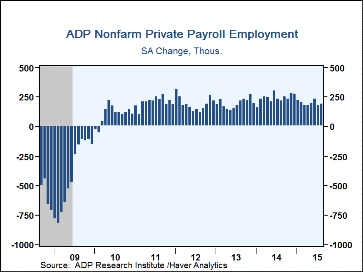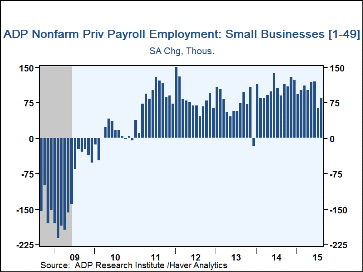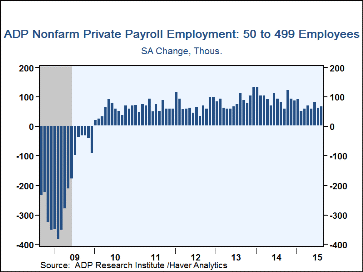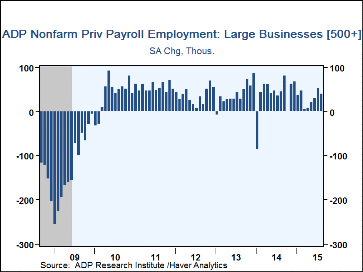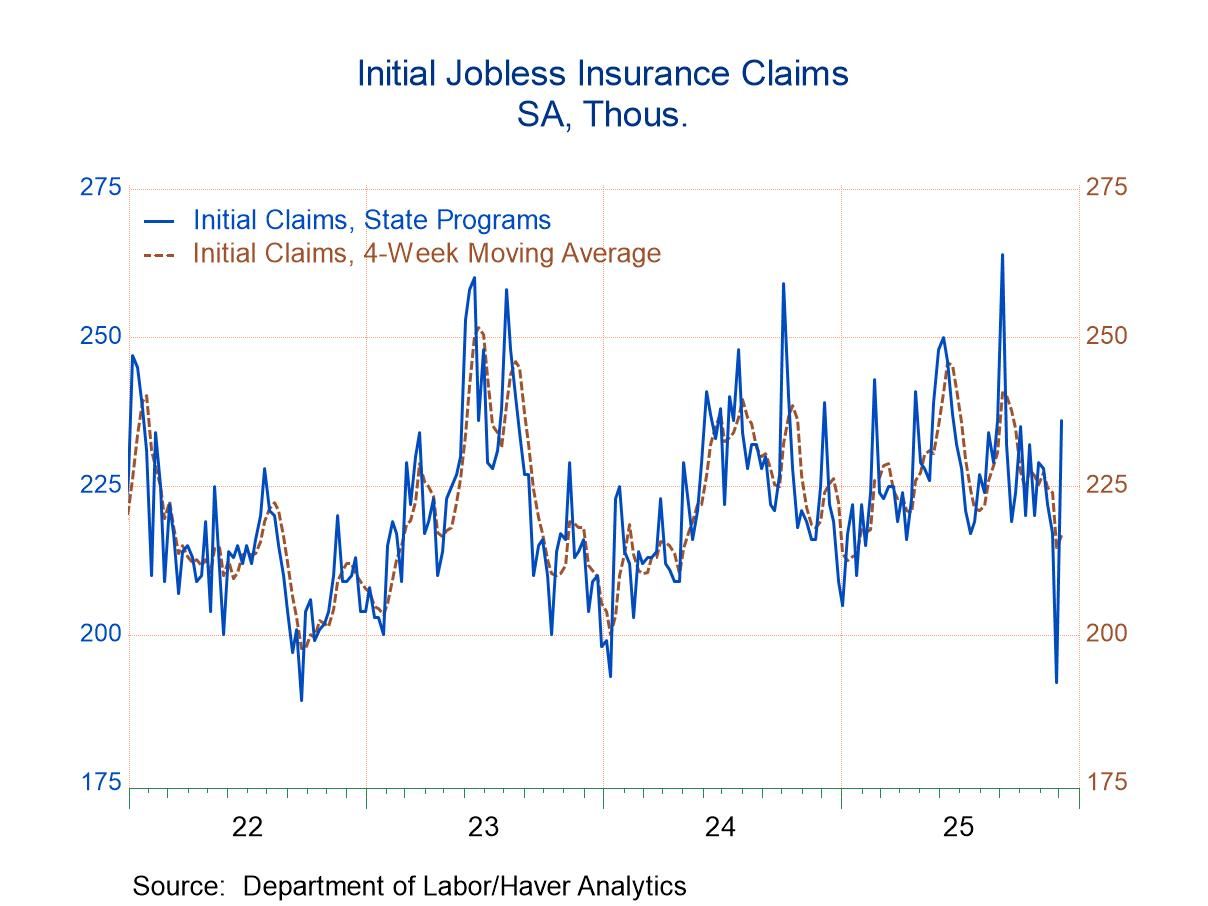 Global| Sep 02 2015
Global| Sep 02 2015U.S. ADP Payroll Increase Is Fairly Stable
by:Tom Moeller
|in:Economy in Brief
Summary
The ADP/Moody's National Employment Report indicated that nonfarm private sector payrolls increased 190,000 during August following a 177,000 July rise, initially reported as 185,000. The gain fell short of consensus expectations for [...]
The ADP/Moody's National Employment Report indicated that nonfarm private sector payrolls increased 190,000 during August following a 177,000 July rise, initially reported as 185,000. The gain fell short of consensus expectations for a 195,000 increase in the Action Economics Forecast Survey. During the last ten years, there has been a 97% correlation between the change in the ADP figure and the change in nonfarm private sector payrolls as measured by the Bureau of Labor Statistics.
The ADP survey is based on ADP's business payroll transaction system covering 411,000 companies and nearly 24 million employees. The data are processed by Moody's Analytics Inc., then calibrated and aligned with the BLS establishment survey data.
Small-sized payrolls improved a moderate 85,000 (2.6% y/y), below the 138,000 high during June last year. Medium-sized payrolls improved a steady 66,000 (2.1% y/y). Large payrolls increased 40,000 (1.7% y/y), up from little m/m growth earlier this year.
Employment in the goods-producing sector rose an improved 17,000 (1.7% y/y). Hiring in construction posted a steady 17,000 increase (4.7% y/y). Manufacturing sector jobs improved a modest 7,000 (0.8% y/y). Jobs in the service sector increased 173,000 (2.3% y/y), down from the 248,000 high during June 2012. Jobs in professional & business services improved 29,000 (2.6% y/y) and trade, transportation & utilities employment increased 28,000 (1.9% y/y). Employment in the financial sector rose 13,000 (1.8% y/y).
The ADP National Employment Report data are maintained in Haver's USECON database; historical figures date back to April 2001. The figures in this report cover jobs only in the private sector. The expectation figure is available in Haver's AS1REPNA database.
The Fed's latest Beige Book covering regional economic conditions is available here.
| ADP/Moody's National Employment Report | Aug | Jul | Jun | Aug Y/Y | 2014 | 2013 | 2012 |
|---|---|---|---|---|---|---|---|
| Nonfarm Private Payroll Employment (m/m chg, 000s) | 190 | 177 | 231 | 2.2% | 2.3% | 1.9% | 2.3% |
| Small Payroll (1-49) | 85 | 63 | 119 | 2.6 | 2.1 | 1.9 | 2.5 |
| Medium Payroll (50-499) | 66 | 61 | 81 | 2.1 | 2.8 | 2.2 | 2.1 |
| Large Payroll (>500) | 40 | 53 | 31 | 1.7 | 1.8 | 1.6 | 2.1 |
| Goods-Producing | 17 | 7 | 13 | 1.7 | 2.3 | 1.7 | 2.2 |
| Construction | 17 | 15 | 17 | 4.7 | 4.6 | 3.5 | 2.5 |
| Manufacturing | 7 | 1 | 8 | 0.8 | 1.2 | 0.9 | 1.6 |
| Service-Producing | 173 | 170 | 218 | 2.3 | 2.3 | 2.0 | 2.3 |
Tom Moeller
AuthorMore in Author Profile »Prior to joining Haver Analytics in 2000, Mr. Moeller worked as the Economist at Chancellor Capital Management from 1985 to 1999. There, he developed comprehensive economic forecasts and interpreted economic data for equity and fixed income portfolio managers. Also at Chancellor, Mr. Moeller worked as an equity analyst and was responsible for researching and rating companies in the economically sensitive automobile and housing industries for investment in Chancellor’s equity portfolio. Prior to joining Chancellor, Mr. Moeller was an Economist at Citibank from 1979 to 1984. He also analyzed pricing behavior in the metals industry for the Council on Wage and Price Stability in Washington, D.C. In 1999, Mr. Moeller received the award for most accurate forecast from the Forecasters' Club of New York. From 1990 to 1992 he was President of the New York Association for Business Economists. Mr. Moeller earned an M.B.A. in Finance from Fordham University, where he graduated in 1987. He holds a Bachelor of Arts in Economics from George Washington University.


